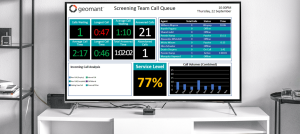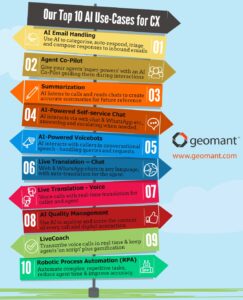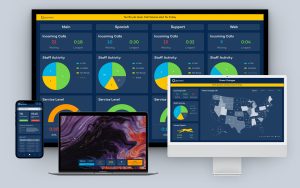If you’re evaluating whether a wallboard solution is the right fit for your contact centre this blog is for you. We’ll review in some detail, the cost aspect of wallboard solutions and will also discuss some of the key benefits they bring to businesses. Let’s get stuck in.
So that we understand what it is we’re talking about here, let’s give a definition of what a contact centre wallboard is:
A contact centre wallboard is a visual communication tool used to display real-time information related to contact centre performance. In the contact centre a wallboard can be configured to display timely data related to the telephony system, agent performance, ticketing systems, ERP, Web content, videos and other information.
What are the different types of Wallboard?
LED wallboards such as the Inova OnAlert M Series display used to be a popular choice for contact centres, they provided easy to see three colour displays. These can be read from over 30 meters away but are becoming less common now due to advances in other screen technology.

The modern-day wallboard provides an end-user with a much more contemporary view in a digital format, with options to display content via large screen TVs or local web browsers on a desktop PC or tablet. The same content can be shown regardless of the display type. There’s also the option to have threshold-type notifications sent to mobile phones. The world of wallboards has evolved a lot.

But how much does wallboard technology cost? What’s involved in going from where you are now to implementing a new solution that aggregates and displays your data? We’ll break it down for you in this next section.
What makes up the cost of a wallboard?
Platform Licence and Support
First you’ll need a platform licence, this is for the use of the core wallboard technology. Most providers will offer a perpetual license for on-premises deployments which will give you access to the technology indefinitely. A price for this is around £4,000 – £8,000 but you’ll need to factor in support costs which is usually a percentage of the licence on top of the initial fee. This can range in relation to the licence cost and level of support needed but to give you an idea, with 8 hours of support five days a week it can be 18% of the licence price, or up to 24% for 12 hours a day seven days a week.
There might also be the option of a subscription-based licence for cloud instances but prices for this would vary from company to company.
Display Licences
Apart from the platform licence, to get set up you’ll also need to budget for display licences. It’s best to have a think about what kind of displays you want to show your data on. Large screen TV license costs are greater than browser player licenses as they offer more functionality. Licences start at around £100 per screen and go up to around £550 for large screen TV’s. Volume discounts tend to apply when more than 10 screens are purchased – the higher the volume the more considerable the discounts are likely to be.
Connectivity Licences
Connectivity licences are the thing that joins up your data with the physical wallboard, the types of things that you can connect to the wallboard displays are almost endless so it’s hard to put a fixed cost on this. However, to give you an idea we’ll try and break it down and let you know what tends to influence the cost.
Certified Connectors
The primary source that most businesses will want to display data from is the telephony or contact centre system. This is particularly the case if the objective of the project is to display contact centre metrics to monitor and improve agent performance. A tip is to look for a provider that specialises in, and focuses on the contact centre, as they are likely to have worked on many similar projects and will no doubt have certified connectors for the major telephony platforms. Having certified connectors tells you two things; firstly, that they are reputable, you need to have passed certain testing criteria to achieve certification status which proves reliability. And secondly, that they will likely be lower cost than other providers, this is because there’s less work involved in getting the data to marry up with the display.
Certified connectivity licenses for listed data sources such as Avaya CMS, Cisco UCCE/X, Genesys, etc. will come to around £5,000 (assuming a typical number of monitored objects). If you have a contact centre platform or telephony system that’s not listed above or are not sure if the provider has a certified connector for what you are using, then it’s best to reach out and ask the question.
The number of queues and agents being monitored will play an important part in pricing these types of connectivity licences. Data source licenses can largely vary from £2,000 to £15,000.
Custom Source Connectivity Licenses
If you find that the provider doesn’t have a connector for the platform you are using, or you have specific requirements like adding a CRM, ticketing or ERP system etc. then you will be looking at what we call a ‘custom source connectivity licence’. These licences start at around £2,000 per data source but could go up to £15,000. The complexity of the connector will affect the cost here, if it’s a simple integration with a source that has readily available APIs then it will be more towards the £2,000 mark but if it’s more complex the cost will rise in line with the complexity.
On a side note, if you know what you want to connect your wallboard with, it’s worth investigating up-front how regularly the data source updates its info. We’ve had situations where a customer has asked us to connect to a solution – let’s call it solution X, but solution X only updates its info every hour meaning it’s not a suitable data source. You need your metrics in real-time or it defeats the object.
In the more complex situations where you have an unlisted data source, you’ll need to go through what’s called a discovery phase where a professional services team evaluate the data source against the requirements, this can take between 5- and 15-man days. A tip if you think that this situation will apply to you, is to make contact with the relevant person at the data source company and introduce them to your wallboard supplier, this will save research time and keep the professional service days and subsequently, the cost down.
Now that we’ve covered licences, let’s talk about the different add-ons that are available.
Optional Features & Services
Trend Analysis Charts
A trend analysis chart does what it says on the tin, rather than simply passing real-time data to the wallboard like calls waiting or current average waiting time, it stores data and processes it to create a history. So you can see things like calls abandoned this hour compared to previous hours in the day, and will be able to analyse the trends. To add this type of functionality costs around £1,500 but the time it saves in manually compiling the data means it pays for itself in the long run.
Wallboard Design Consultancy
Unless you have a specialist team in house you might need help with creating the first wallboard displays. Typically, ½ a day’s training will cost around £515 and is sufficient to design one wallboard which will set you up to then go on and create your own.
Recommendation: You want to look for a solution that has a user-friendly editor, the last thing you want is to go live and then not have the capability to make any changes. An easy-to-use editor means that after some initial training you’ll be self-sufficient.
What are the benefits of each type of wallboard?
We mentioned before that there are different display options and costs associated with licences for those different options vary, let’s take closer look at the advantages of each type to help you with the selection process:
Choosing Large TV Screen licenses over Web Browser licenses.
Large TV screen licenses allow an administrator to control the content being displayed at any time from a centralised web admin portal, which means you don’t have to be near the screen to update its content. With web browser licenses, the host display requires the local input of a URL to access the wallboard content.
Large Screen TV displays are typically used to display data to a large team over a contact centre floor. You can display a small number of high-level KPI’s (e.g. team SLAs) that will encourage agents to work together towards the success of the contact centre. If you need more detailed data in your displays (e.g. agent statuses), the local web browser displays are a better choice for supervisors and team leaders. Keep in mind though, that there’s no reason you can’t mix and match – we tend to see a supervisor/managers having browser-based displays with agents having view of a large screen TV.
How to get started what’s involved in set up?
If you’re still considering wallboard, at this point you might be asking yourself the question “how do I get started?”. The first thing you need to do is ensure that you can answer the following questions:
- What do the contact managers need to see on these displays? What problem are they trying to solve with wallboards?
- Who is the audience for the displays – the agents or the management team or both?
- What data do they want to display (be specific because telecom will need to know this)? Your choices are; group-level data, historical trending data, and agent state.
- Other than call data, is there any other data they need to see in real-time? It is good to find out what the agents/managers are incentivised on and make sure those metrics are available.
- Discuss messaging needs. Is the goal of the signage to focus and empower agents or to motivate them and keep them happy – or both?
- Will you need to show different data/content in different areas to match the audience, i.e. will Customer Service see only customer service calls, while a group in a separate room – Collections, will see only collection calls or will a summary screen of all play on all of the screens?
Once you can confidently answer all the above, you can start to engage with wallboard vendors and begin to understand the software options that are out there. The wallboard provider will walk you through the rest of the process as it will be individual to them, but the main stages for most projects are:
- Needs analysis – The provider will ask you all the above questions to gauge requirements.
- Wallboard demo – You’ll usually have a demo session after the needs analysis stage where you get to see the solution in action. Note: the demo session should be tailored to your specific requirements and not just a one-size-fits-all demo.
- Proposal – If you’re happy with the product and the vendor you can move to the proposal stage, this is where you’ll be given a contract-type document outlining the project and costs.
- Contract – If you’re happy you’ll accept the proposal and a contract will be drawn up.
- Project plan – A project plan will be produced which details important milestones and timelines.
- Project start – You would have needed to procure any screens by now, the server will be installed (if required) and the project will start.
- Go live – Typically, you’ll be up and running within 2-4 weeks from the project start date.
Business benefit
Wallboard is a great investment for any contact centre who wants to remain competitive; it has advantages for agents, managers, and customers alike. You can read all about the benefits of wallboard for contact centres in our eBook:
{{cta(‘251c321c-ac3d-407c-a1fa-b14b0b1b82cb’)}}
Buying recommendations
We hope you’ve found this blog useful. Let’s end with a summary of buying recommendations:
- Look for a provider that specialises in the contact centre that has certified connectors for the leading telephony platforms.
- Look for a wallboard supplier that has an easy-to-use editor tool so that you can be self-sufficient after deployment.
- Don’t lose your vision throughout the project, remember what the core business need is for the wallboard. We recommend you start with the immediate business need then build your wallboard and digital signage content following end-user training.
- Use the large TV screen license if you want to show content to large groups and control that content centrally via web admin portal.
- Design your displays according to the device. Large screen TVs are good for showing a small number of high-level KPI’s (e.g. abandoned calls) while web browser screens are good for showing more detail (e.g. agent statuses).
- Consider emergency screens, audible alerts and content rotation when designing your wallboard displays.











